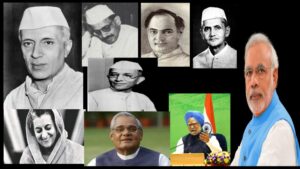Table of Contents
INTRODUCTION
PRIME MINISTERS OF INDIA
A prime minister, premier, or chief of the cabinet is the head of the cabinet and the leader of the ministers in the executive branch of government, often in a parliamentary or semi-presidential system.
Article 75 of the Indian Constitution mentions that a Prime Minister is one who is appointed by the President. There is no specific procedure for his election or appointment.
India has had 15 Prime Ministers to date (excluding the interim Prime MInisters), with Uttar Pradesh being the state which has given the most number of Prime Ministers

Who is eligible to be a Prime Minister?
To become an Indian prime minister one has to be
- A citizen of India.
- A member of either Rajya Sabha or Lok Sabha
- He should have completed his 30 years if he is a member of the Rajya Sabha or can be 25 years of age if he is a member of the Lok Sabha
1947-2022 LIST OF PRIME MINISTERS OF INDIA
| SR.NO | Prime Minister | Term of the Office | REMARKS |
| 1 | Pandit Jawaharlal Nehru | 15th Aug 1947- 27th May 1964 | The first & longest-serving PM of India who is also the first to die in office |
| 2 | Gulzarilal Nanda (interim) | 27th May 1964- 9th Jun 1964 | First acting PM of India |
| 3 | Lal Bahadur Shastri | 9th June 1964 -11th January 1966 | He was also famous for his slogan ‘Jai Jawan Jai Kisan’ during the Indo-Pak war, in 1965 |
| 4 | Gulzarilal Nanda | 11th January 1966- 24th January 1966 | |
| 5 | Indira Gandhi | 24th January 1966- 24th March 1977 | The first female Prime Minister of India |
| 6 | Morarji Desai | 24th March 1977- 28th July 1979 | Oldest PM of India (81 years old) and the first to resign from office |
| 7 | Charan Singh | 28th July 1979- 14th January 1980 | The only PM who did not face the Parliament |
| 8 | Indira Gandhi | 14th January 1980- 31st October 1984 | First lady PM who served the second term |
| 9 | Rajiv Gandhi | 31st October 1984- 2nd December 1989 | Youngest to become PM (40 years old) |
| 10 | Vishwa Pratap Singh | 2nd December 1989- 10th November 1990 | First PM to step down after a vote of no confidence |
| 11 | Chandra Shekhar | 10th November 1990-21st June 1991 | Belonged to Samajwadi Janata Party |
| 12 | P. V Narasimha Rao | 21st June 1991- 16th May 1996 | First PM from south India |
| 13 | Atal Bihari Vajpayee | 16th May 1996-1st June 1996 | PM for the shortest term |
| 14 | H. D Deve Gowda | 1st June 1996- 21st April 1997 | Belonged to Janata Dal |
| 15 | Inder Kumar Gujral | 21st April 1997- 18th March 1998 | |
| 16 | Atal Bihari Vajpayee | 18th March 1998- 22nd May 2004 | A first non-congress PM who completed his full term as PM of India |
| 17 | Dr. Manmohan Singh | 22nd May 2004 -17th May 2014 | First Sikh PM of India |
| 18 | Narendra Modi | 26th May 2014 – Till date | 4th Prime Minister of India who served 2 consecutive terms |
Power and Function of Prime Minister
The Prime Minister of India serves the country by following various functions. He performs his functions taking responsibilities as:
- The leader of the Country: The Prime Minister of India is the Head of the Government of India.
- Portfolio allocation: The Prime Minister has the authority to assign portfolios to the Ministers.
- Chairman of the Cabinet: The Prime Minister is the chairman of the cabinet and presides over the meetings of the Cabinet. He can impose his decision if there is a crucial opinion difference among the members.
- Official Representative of the country: Prime minister represents the country for high-level international meetings
- The link between the President and the Cabinet: The Prime Minister acts as the link between President and cabinet. He communicates all decisions of the Cabinet to the President which is related to the administration of the affairs of the Union and proposals for legislation.
- Head: The Prime Minister is the head of the Nuclear Command Authority, NITI Aayog, Appointments Committee of the Cabinet, Department of Atomic Energy, Department of Space and Ministry of Personnel, Public Grievances and Pensions.
- Chief Advisor: He acts as the chief advisor to the President
Position of the Prime Minister
Right from the days of the first Prime Minister Pandit Jawaharlal Nehru, the Prime Minister is treated at a much higher pedestal. His preeminence rests on his commanding position in the Cabinet, coupled with the fact that he is the leader of the majority party.
All these positions of power when combined in one person make him rank much above an ordinary Minister. The death or resignation of the Prime Minister automatically brings about the dissolution of the Council of Ministers. It generates a vacuum. The demise, resignation, or dismissal of a Minister creates only a vacancy that the Prime Minister may or may not like to fill. The Government cannot function without a Prime Minister but the absence of a Minister can be easily compensated.
MUST READ
CAN A RETAILER CHARGE MORE THAN MRP?
IS WATCHING PORN A CRIME IN INDIA?
LAWS AND RIGHTS FOR EVERY INDIAN
CALL RECORDINGS USED AS EVIDENCE IN COURTS
